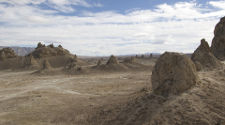
Searles Lake, located near Death Valley, California, is an evaporite basin containing smectite mudstones that have been altered under mildly alkaline conditions (9 < pH < 10) over a 3 million year period.
The site is a useful natural analogue for the study of potentially deleteriouteration of clays by cementitious porewaters in geological repositiories for radioactive wastes. Whilst the pH is lower than that associated with the use of fresh Ordinary Portland Cement (OPC) it is representative of conditions after fresh OPC has undergone partial reaction with geological materials, or where the use of "Low pH cements" is being considered with the intention of reducing the potential amount of clay alteration.
Working with JAEA, Quintessa have developed a model of the system using Quintessa's general purpose modelling tool, QPAC. QPAC allows the user to construct models using a range of pre-existing modules that implement frequently needed process and to couple these to custom models implementing new or application-specific processes. The model simulates the flows and reactions in the gradually forming sediment column, with flows varying with time as deeper-lying sediments undergo compaction and become more resistive to flow. To construct the model, the QPAC reactive transport module was coupled to a custom model for the evolving hydrogeology that includes a simplified effective stress model to simulate the compaction of the sediments. Due to the highly saline nature of the historic porewaters at Searles Lake, the Pitzer virial model for aqueous activities was incorporated into the model. Pitzer data from the Yucca Mountain database was used in the simulations. The results of the simulations compare well with core samples taken from the site.
The animation below illustrates some of the results obtained in simulations of the Searles Lake natural analogue.
